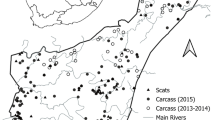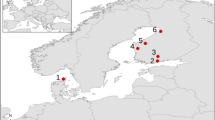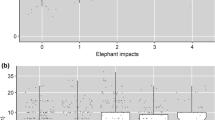Abstract
Large mammalian carnivores place significant pressure on their prey populations and this is exacerbated within the fenced reserves of Africa. However, foraging theory predicts that diet switching by predators may mitigate this pressure. In this study, we use data collected between 2003 and 2007 from an enclosed system in the Eastern Cape Province of South Africa to examine the response of lions Panthera leo to changes in the abundance of two important prey species — kudu Tragelaphus strepsiceros and warthog Phacochoerus africanus. As the relative abundance of warthogs increased, the number of kudu kills decreased significantly, whereas warthog kills became significantly more frequent. A similar pattern was observed for lion prey preference and the switch from kudu to warthog was also reflected in a significant decrease in the mean prey mass. Our results suggest that a diet shift occurs in lions and that the change in diet is primarily in response to an increase in warthog numbers. Prey switching may promote the persistence of predator–prey systems, which is particularly important for fenced systems where natural immigration of prey is not possible. However, continued collection and analysis of long-term observational data from the multipredator, multiprey systems of Africa is required to facilitate a full understanding of predator–prey dynamics.


Similar content being viewed by others
References
Begg CB, Begg KS, du Toit JT, Mills MGL (2003) Sexual and seasonal variation in the diet and foraging behaviour of a sexually dimorphic carnivore, the honey badger (Mellivora capensis). J Zool 260:301–316
Bertram BCR (1973) Lion population regulation. E Afr Wildl J 11:215–225
Bissett C (2007) The feeding and spatial ecologies of the large carnivore guild on Kwandwe Private Game Reserve. PhD thesis, Rhodes University, Grahamstown
Bissett C, Bernard RTF (2007) Habitat selection and feeding ecology of the cheetah (Acinonyx jubatus) in thicket vegetation: is the cheetah a savanna specialist? J Zool 271:310–317
Bothma JduP (2002) Game Ranch Management, 3rd edn. Van Schaik Publishers, Pretoria
Bothma JduP, du Toit JG (2010) Game Ranch Management, 5th edn. Van Schaik Publishers, Pretoria
Canepuccia AM, Martinez MM, Vassallo AI (2007) Selection of water birds by Geoffroy’s cat: effects of prey abundance, size and distance. Z Saugetierkd 72:163–173
Carss DN, Elston DA, Morley HS (1998) The effects of otter (Lutra lutra) activity on spraint production and composition: implications for models which estimate prey-size distribution. J Zool 244:295–302
Dell’Arte GL, Laaksonen T, Norrdahl K, Korpimäki E (2007) Variation in the diet composition of a generalist predator, the red fox, in relation to season and density of main prey. Acta Oecol 31:276–281
Estes JA (1994) Top-level carnivores and ecosystem effects: questions and approaches. In: Jones CG, Lawton JH (eds) Linking species and ecosystems. Springer-Verlag, New York, pp 151–158
Funston PJ, Mills MGL, Biggs HC (2001) Factors affecting the hunting success of male and female lions in the Kruger National Park. J Zool 253:419–431
Garrott RA, Bruggeman JE, Becker MS, Kalinowski ST, White PJ (2007) Evaluating prey switching in wolf-ungulate systems. Ecol Appl 17:1588–1597
Hanski IH, Henttonen H, Korpimäki E, Oksanen L, Turchin P (2001) Small rodent dynamics and predation. Ecology 82:1505–1520
Hayward MW (2011) Scarcity in the prey community yields anti-predator benefits. Acta Oecol 37:314–320
Hayward MW, Kerley GIH (2005) Prey preferences of the lion (Panthera leo). J Zool 267:309–322
Hayward MW, Adendorff J, O’Brien J, Sholto-Douglas A, Bissett C, Moolman LC, Bean P, Fogarty A, Howarth D, Slater R, Kerley GIH (2007a) The reintroduction of large carnivores to the Eastern Cape Province, South Africa: an assessment. Oryx 41:205–214
Hayward MW, O’Brien J, Hofmeyr M, Kerley GIH (2007b) Testing predictions of the prey of lion derived from modelled prey preferences. J Wildl Mgmt 71:1567–1575
Höner OP, Wachter B, East ML, Hofer H (2002) The response of spotted hyaenas to long-term changes in prey populations: functional response and interspecific kleptoparasitism. J Anim Ecol 71:236–246
Hunter L (1998) The behavioural ecology of reintroduced lions and cheetahs in Phinda Resource Reserve. PhD thesis, University of Pretoria, Pretoria
Jacobs J (1974) Quantitative measurement of food selection. Oecologia 14:413–417
Korpimäki EK, Krebs CJ (1996) Predation and population cycles of small mammals. BioScience 46?754–764
Křivan V (1996) Optimal foraging and predator–prey dynamics. Theor Popul Biol 49:265–290
Ma BO, Abrams PA, Brassil CE (2003) Dynamic versus instantaneous models of diet choice. Am Nat 162:668–684
MacArthur R, Pianka ER (1966) An optimal use of a patchy environment. Am Nat 100:605–609
Meena V, Jhala YV, Chellam R, Pathak B (2011) Implications of diet composition of Asiatic lions for their conservation. J Zool 284:60–67
Meissner HH (1982) Theory and application of a method to calculate forage intake of wild southern African ungulates for purposes of estimating carrying capacity. S Afr J Wildl Res 12:41–47
Mucina L, Rutherford MC (2006) The vegetation of South Africa, Lesotho and Swaziland. South African National Biodiversity Institute, Pretoria
Murdoch W (1969) Switching in general predators: experiments on predator specificity and stability of prey populations. Ecol Monogr 39:335–354
Murrell DJ (2005) Local spatial structure and predator–prey dynamics: counterintuitive effects of prey enrichment. Am Nat 166:354–367
O’Donoghue MB, Boutin S, Krebs CJ, Murray DL, Hofer EJ (1998) Behavioural responses of coyotes and lynx to the snowshoe hare cycle. Oikos 82:169–183
Owen-Smith N, Mills MGL (2008) Shifting prey selection generates contrasting herbivore dynamics within a large-mammal predator–prey web. Ecology 89:1120–1133
Packer C, Scheel D, Pusey A (1990) Why lions form groups: food is not enough. Am Nat 136:1–19
Pech RP, Sinclair ARE, Newsome AE, Catling PC (1992) Limits to predator regulation of rabbits in Australia: evidence from predator-removal experiments. Oecologia 89:102–112
Perry G, Pianka ER (1997) Animal foraging: past, present and future. Trends Ecol Evol 12:360–364
Power RJ (2002) Evaluating how many lions a small reserve can sustain. S Afr J Wildl Res 33:3–11
Pyke GP, Pulliam HR, Charnov EL (1977) Optimal foraging: a selective review of theory and tests. Q Rev Biol 52:137–154
Radloff FGT, du Toit JT (2004) Large predators and their prey in a Southern African savanna: a predator’s size determines its prey size range. J Anim Ecol 73:410–423
Randa LA, Cooper DM, Meserve PL, Yunger JA (2009) Prey switching of sympatric canids in response to variable prey abundance. J Mammal 90:594–603
Reilly BK (2002) Precision of helicopter-based total-area counts of large ungulates in bushveld. Koedoe 45:77–83
Reilly BK, Emslie RH (1998) Power and precision of replicated helicopter surveys in mixed bushveld. Koedoe 41:47–56
Schaller GB (1972) The Serengeti lion: a study of predator–prey relations. The University of Chicago Press, Chicago
Skinner JD, Chimimba CT (2005) The mammals of the Southern African subregion, 3rd edn. Cambridge University Press, Cape Town
Sundell J, Eccard JA, Tiilikainen R, Ylönen H (2003) Predation rate, prey preference and predator switching: experiments on voles and weasels. Oikos 101:615–623
van Baalen M, Křivan V, van Rijn PCJ, Sabelis MW (2001) Alternative food, switching predators and the persistence of predator–prey systems. Am Nat 157:1–13
van Orsdol KG (1982) Feeding behaviour and food intake of lion in Rwenzori National Park, Uganda. In: Miller SD, Everet DD (eds) Cats of the world: biology, conservation and management. National Wildlife Federation, Washington, pp 377–388
Viljoen PC (1993) The effects of changes in prey availability on lion predation in a large natural ecosystem in northern Botswana. Symp Zool Soc Lond 65:193–213
Viljoen PC (1997) Ecology of lions in Northern Botswana. In: Penzhorn BL (ed) Lions and leopards as game ranch animals. Proceedings of a symposium on lions and leopards as game ranch animals, Pretoria, pp 37–49
Williams TM, Estes JA, Doak DF, Springer AM (2004) Killers appetites: assessing the role of predators in ecological communities. Ecology 85:3373–3384
Acknowledgments
Our sincere thanks go to Angus Sholto-Douglas of Kwandwe Private Game Reserve for providing logistical and financial support for this project. We acknowledge the staff of Kwandwe for providing assistance and information. All experiments complied with the ethical protocols of Rhodes University and the laws of South Africa. Matt Hayward and two anonymous referees are thanked for constructive comments on earlier drafts of the manuscript.
Author information
Authors and Affiliations
Corresponding author
Additional information
Communicated by: Dries Kuiper
Rights and permissions
About this article
Cite this article
Bissett, C., Bernard, R.T.F. & Parker, D.M. The response of lions (Panthera leo) to changes in prey abundance on an enclosed reserve in South Africa. Acta Theriol 57, 225–231 (2012). https://doi.org/10.1007/s13364-011-0071-8
Received:
Accepted:
Published:
Issue Date:
DOI: https://doi.org/10.1007/s13364-011-0071-8




